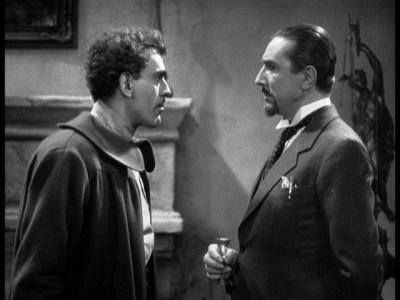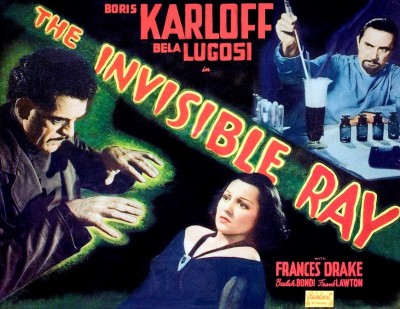
This is by way of being the Thursday Horror Picture Show’s Christmas special. It’s special in the sense that Lambert Hillyer’s The Invisible Ray (1936) received the most enthusiastic reception of just about anything that’s been run in the past two-and-a-half years. Of course, audiences differ greatly and even the same audience won’t respond the same way at a later date, but I can’t conceive of anyone — at least anyone who doesn’t have the “but it’s old and in black and white” mindset — not enjoying this film. It’s the third of the Karloff-Lugosi outings, and while it’s not as good as The Black Cat (1934) nor as wild as The Raven (1935), it may just be the most fun. It’s easily the most elaborate of the three and the most expensively made. While some of the sets are recycled and some of the props as well (the same control panel appears in all three movies), this is one solid production with first-rate effects work that hold up surprisingly well today. (The “science” doesn’t hold up as well, but I’m assuming no one goes to these movies expecting that sort of thing to be accurate — or even necessarily sane.) The film’s trip into space is pretty darn impressive and the effect of having Karloff glow like the dial on a Baby Ben alarm clock after he’s poisoned by Radium X is right on the money. Adding to the package is a splendid original musical score by Franz Waxman. (Well, nearly original — one bit of music is borrowed from his score from the previous year’s James Whale mystery-comedy Remember Last Night?.)

What really sells the film is less its impressive look and sound or unusually expansive length (at 80 minutes, it’s 15 minutes longer than either of the others), but more the fact that it’s completely all about its two stars. The movie is only a few minutes old when Dr. Janos Rukh (Karloff) and Dr. Felix Benet (Lugosi) have their first confrontation — even it it’s only a duel of mild insults. It’s perfect and it perfectly embodies the fact that whether either actor much liked the other, there’s something that happens — some inexplicable chemistry — when they’re in the same movie that doesn’t happen in their solo efforts. The odd thing here is that it’s Karloff, who slices the ham thick (and early and often), and Lugosi who underplays. It’s almost as if they’re playing each other’s roles — and it has been suggested that the casting was originally reversed. I can see that possibility and I wouldn’t have minded it, but here we get something different — Karloff running wild-eyed and Lugosi playing everything with sardonic amusement. It’s a nice touch. I can’t think of two actors I’d rather go globetrotting with — the movie goes from the Carpathian Mountains to Darkest Africa to Paris (with a side-trip to outer space early on) — than this duo.

The film itself is of particular note because it’s really the first sound film — at least in Hollywood — that can properly be termed science fiction. Of course, since that was new territory for the studio, it became very gothic horror science fiction. You can, in fact, make a case that the film contains the birth of the “new” genre out of the old. The film opens at one of those castles that dot the Carpathian Mountains of screenwriters’ imaginations — and everything is geared toward horror with both an oversized thunderstorm and Waxman’s score working overtime to generate horror movie atmosphere, even though nothing much is happening other than Diana Rukh (Frances Drake) walking from the castle to her husband’s laboratory. Soon, however, this gives way to the science fiction angle and we realize that nothing supernatural is going to happen. That the film retains much its gothic ambience is hardly surprising, since that’s what Universal knew best. It’s interesting to wonder how things might have developed if the Laemmles hadn’t lost the studio soon afterwards — a misfortune of incalculable import to the horror genre.
The Thursday Horror Picture Show will screen The Invisible Ray Thursday, Dec. 20 at 8 p.m. in the Cinema Lounge of The Carolina Asheville and will be hosted by Xpress movie critics Ken Hanke and Justin Souther.




Before you comment
The comments section is here to provide a platform for civil dialogue on the issues we face together as a local community. Xpress is committed to offering this platform for all voices, but when the tone of the discussion gets nasty or strays off topic, we believe many people choose not to participate. Xpress editors are determined to moderate comments to ensure a constructive interchange is maintained. All comments judged not to be in keeping with the spirit of civil discourse will be removed and repeat violators will be banned. See here for our terms of service. Thank you for being part of this effort to promote respectful discussion.